You are here: Foswiki>Dmi Web>WinterSchool2018>WinterSchool2018BoundariesEntrepreneurialJournalism (30 May 2018, MichaelStevenson)Edit Attach
- Field analytics: prestige and position-taking among journalistic startups
Field analytics: prestige and position-taking among journalistic startups
1. Introduction
Today, journalism is facing fundamental challenges to both its financial viability and its role as society’s arbiter of truth (Singer, 2010; Wahl Jorgenson, 2016). These developments are considered a serious threat for democratic society (McNair, 2013). Particularly the established news outlets are blamed for being complicit in this development. It is the most recent chapter in a broader critique of legacy news media, diagnosing it as an industry that can no longer sustain itself economically, and reproaching it for no longer living up to their self-acclaimed role of informing citizens and monitoring society (Broersma & Peters, 2016).This is attested by the rapid rise of journalistic startups in different countries, such as [example] or [example] in the US, De Correspondent or Follow The Money in the Netherlands, and Krautreporter or Correktiv in Germany. Strategically riding the wave of critique on legacy news media, these outlets claim that traditional outlets are performing below par, simultaneously using this critique to position themselves in the field. They for instance argue that legacy media squandered journalism’s authority by choosing profit over quality, fail to engage the public, are not up to date on the latest technologies to help them (re)structure their journalistic practices, and hold on to a dying business model. The startups present themselves as a much-needed break with the establishment, aiming to restore and reinvigorate journalism both as a commercial industry and a professional practice (Wagemans, Witschge & Deuze, 2016; Harbers, 2016; something more on the commercial side).This project seeks understand this process of in which new players aim to innovate and rethink journalism, while acknowledging the strategic nature of the startups’ ‘discourse of innovation’ (Carlson & Usher, 2015). Moreover, by adopting a cross-national perspective it can discount for the variety of culture-specific ways in which new journalistic startups are organizing themselves institutionally and commercially, and how they are renegotiating their professional practice (Hallin & Mancini, 2004; Hanitzsch, 2007). The project takes its inspiration from the French sociologist Pierre Bourdieu, who provided a theoretical framework for the analysis of social mobility that he called ‘field theory.’ Bourdieu's research was primarily focussed on the dynamics of power in society. He states that the social world is comprised from different fields that in their exist out of different actors and their (hierarchical) relation to each other as well as a set of social rules. An actor’s position in the field is determined by their (successful) compliance of the social rules and the capital they bare (Bourdieu 243). Here, we apply this thinking to the field specific competition for being recognized as 'innovative' within journalism.2. Facilitators and project members.
The project was led by researchers Michael Stevenson and Frank Harbers. The vast majority of the research was carried out by project members Henrik Bodker, Claire Gersen, Thomas de Man, Lune van der Meulen, Katrin Puvogel, Mariessa Radermacher, Vera Seegers, Sozan Toksoz and Maximilian Zucchet. Data visualizations and additional facilitation were provided by Andrea Benedetti and Giacomo Flaim. Further tool and method support was provided by Erik Borra, Emile den Tex and Richard Rogers.3. Research questions and method
The research aimed to understand (1) which startups and other actors are recognized as innovative in different national contexts and (2) how these actors are positioned relative to each other in terms of market success, symbolic power and discursive association. To achieve this, we drew on a mix of digital methods approaches to building source sets and gathering web and social media data, and performed a mix of quantitative and qualitative forms of analysis, most notably content analysis and network analysis. Our research focused on three national contexts: Germany, the Netherlands and USA. Although this was driven in part by practical considerations, there are several reasons for comparing these: In all three countries the debates on journalism's future are at the forefront, acknowledging the need for innovation. Yet, their startup climates differ considerably (Bruno & Nielsen, 2012; Witschge & Deuze, 2014). Additionally, the journalistic traditions related to the cultural & socio-political context of the respective countries diverge (Hallin & Mancini, 2004). Comparing startups in these countries can therefore be embedded in existing research into the divergent startup climates as well as into the general differences in institutional organization, journalism’s relation to other cultural domains such as politics or literature, and professional framework. This allows the project to reveal how different national environments shape the discourse on journalistic innovation and the strategies used by startups to position themselves in the field (Benson, 2005; Hanitzsch, 2007).Compiling lists of journalistic startups
To create source sets of startups and other journalistic actors recognized as being innovative, we performed what Rogers (ref needed) calls associative query snowballing. Beginning with a few organizations we were fully confident belonged in our data set, we queried those organizations in combination to find articles that were (a) about journalism and innovation in a broad sense and (b) included mention of new actors to add to our list. This process was carried out per country and repeated until saturation, producing lists of 43 startups for Germany, 45 for the Netherlands, and 35 for the USA. It should be noted that we were inclusive by design: for example, because the now defunct US gossip blog Gawker continues to be mentioned within the context of journalism and innovation, we kept this in our data set. Likewise, while many of the organizations we found are relatively old (e.g. we included Slate magazine, founded in 1996), we included them because of their continued presence in discussions of the changing journalism landscape. In other words, we see the diversity of the relative ages and sizes of these 'startups' as a feature rather than a bug, as this reflects how definitions of media actors' 'newness' or 'innovativeness' are less about temporal distinctions and more about socially constructed imaginaries in which sets of characteristics and values are discursively attached to 'old' and 'new' media (Stevenson, 2016).Measuring market success and prestige
In order to position the startups in a visual graph, we used the number of social media followers (high market success) as a means to establish the x-axis and the number of mentions within the discourse (prestige) as the y-axis. To make the figures comparable, we applied a logarithm 10 calculation and a standardization equation on the logarithmized numbers. The graph contains a range from -7 to +7 on the x-axis, whilst the y-axis shows a range from -5 to +5. Then, all figures were comparable and hence, this allowed us to position the startups according to the x and y-value into the four quadrants. This resulted in a different distributions among the graph for all three countries investigated.Mapping actor positioning on Facebook
In order to map how the actors position themselves on social media, we gathered the Facebook page like network from all the three startup groups: USA, Germany and the Netherlands. We used Lookup-ID.com to get the unique Facebook ID by inserting the Facebook profile URL. Then we used the Netvizz tool to download the page like network for every single startup in order to see how the startups position themselves in the media and cultural landscape and how they relate to each other. Additionally, we put this data set into Gephi for visualizing the network and to see which and what kind of clusters precisely appeared. From this the actual position of the startups at this moment could be concluded. We used all of the data points for our analysis, besides the actors with a “talking about count” lower than 1. For the layout we used the Force Atlas 2 module and clustered all the nodes with the modularity rank in order to make communities visible. Our outcome were three different page like networks: one for each country based on the startup list we created beforehand. These visualized networks enable us to further analyze where startups position themselves within the media landscape.Mapping actors' discursive positions within the innovation discourse
Compiling lists of key innovation terms
Drawing on the innovation discourse mentioned above, we compiled a list of terminology used within it. As we considered keywords that appeared repetitively to be characteristics of how innovative journalism can be described, a manual and inductive content evaluation pinpointed the terms and phrases connotated to innovative or entrepreneurial journalism. For each country, we determined approximately 100 keywords. In order to validate the results across the three countries, we then translated and compared the lists. To ensure replicability across languages and avoid bias, unique terms from other lists were queried with the Google Scraper in the national “discourse media” and added to the list if they appeared to be significant in this country’s innovation discourse.Analyzing the discourse associated with individual actors
To analyze which key terms are associated with which startup, we identified three articles in discourse media for each startup and queried these articles for the key terms. The articles were chosen from the Google Scraper results of measuring the prestige. From the collection of links where a startup is mentioned, we manually decided on three rather descriptive and focused texts, for example through ensuring that the startup had to be described as an innovative player. Eventually, three startups per quadrant and three articles each were selected to be analyzed in terms of the discourse associated with these individual actors. However, the research left out the bottom left quadrant of “new entrants and failed startups” in all three countries, and for the USA also the top right of “the new establishment.” With the Google Scraper (Lippmanian Device) we queried each article for all the innovation key terms, setting the number of results to 1. Once we had a list of all terms mentioned in association with each startup, we combined them into a new list of all terms associated with each quadrant: for example, words like “democracy” or “quality” dominate the “purist”-quadrant in the USA, while the “symbolically excluded” are associated with key terms like “advertorial” or “revenue.” From this, we could create a wordcloud via wordle.net that visualized the key terms according to their count. Within this creation of wordclouds, we excluded terms like Facebook and Twitter due to the fact that they were counted to be present in the article, only when the website implemented the so-called social buttons.Limitations
In addition to limitations of this project lie partly in the tools used: It was expected to do the research with an outcome of 100 results per query in the Google Scraper. However, the Google Scraper works rather slowly, so the number of results per query had to be decreased step by step. Accordingly, as we were also limited to the one-week-timeframe, some queries could not be finished before finalizing the data sprint. Thus, for example some wordclouds were not created. Additionally, it is not possible to specify the queries in the Scraper. Therefore, we had to exclude several publications as their names (“Berlin Valley”, “Vice”, “Now Media”) were used in various unrelated contexts, producing significant bias.4. Results and visualizations
The visualizations we created show (1) the new players by considering their market success and prestige (2) the innovation discourse associated with the actors and (3) how actors position themselves within their Facebook page like network.a. Measuring symbolic capital and market success
For example in The Netherlands, in the upper right quadrant, organisations like Blendle, or De Correspondent can be found, that are clearly recognized as innovative players by the legacy media as well as in the innovation discourse, but are also very popular considering Facebook likes and Twitter followers (new establishment). On the upper left, we see players like localfocus, recognized and appreciated by their peers, but not high in popularity (Purist and producers for producers). In the lower left quadrant we find recent entrants or failing startups, low on prestige as well as on popularity. And finally, on the lower right, we find players that are not recognized as innovative, but that are very popular (The symbolically excluded). Similar results can be seen in Germany and the USA.Symbolic capital and Market Success (NL):
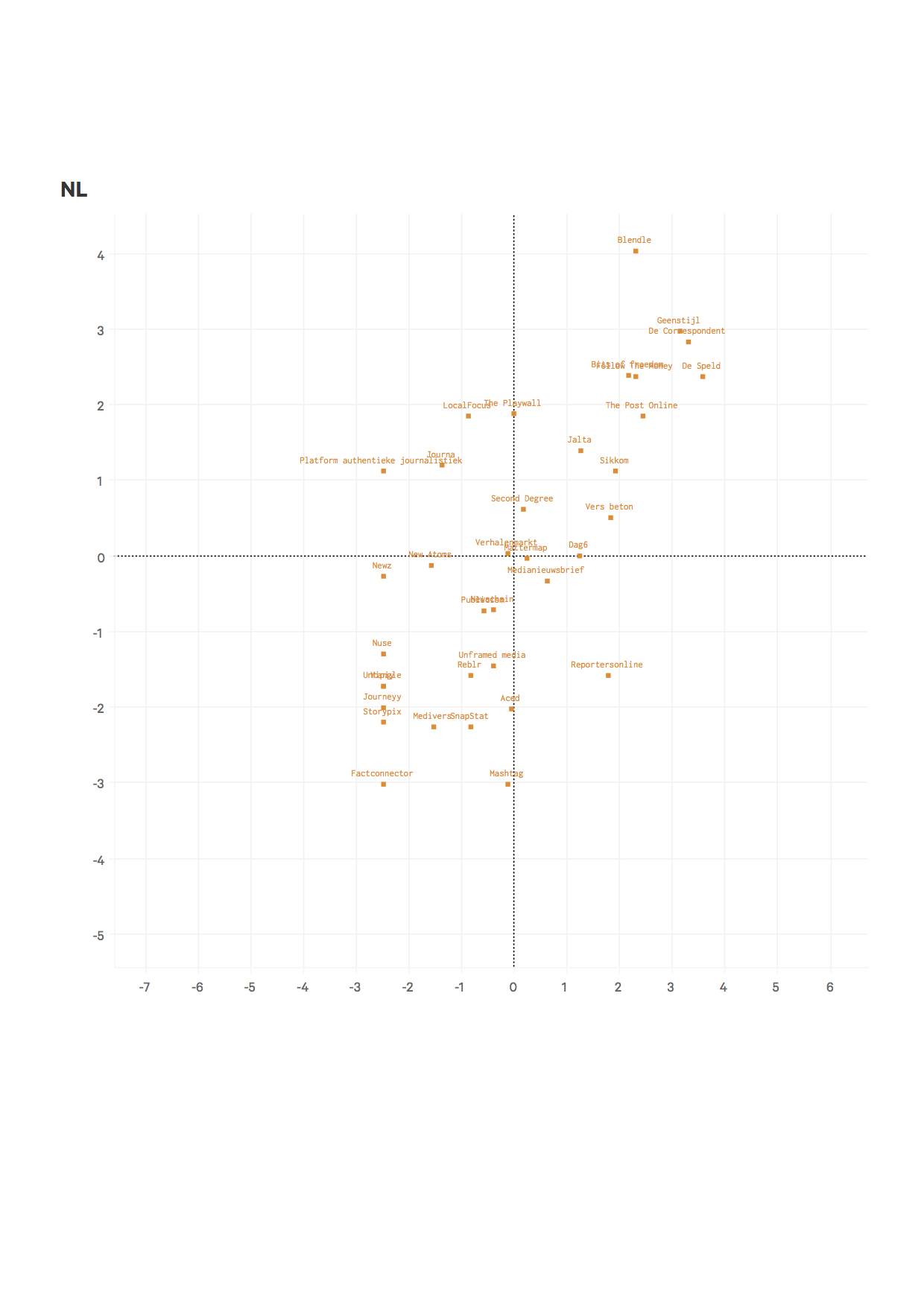
Symbolic capital and Market Success (DE):
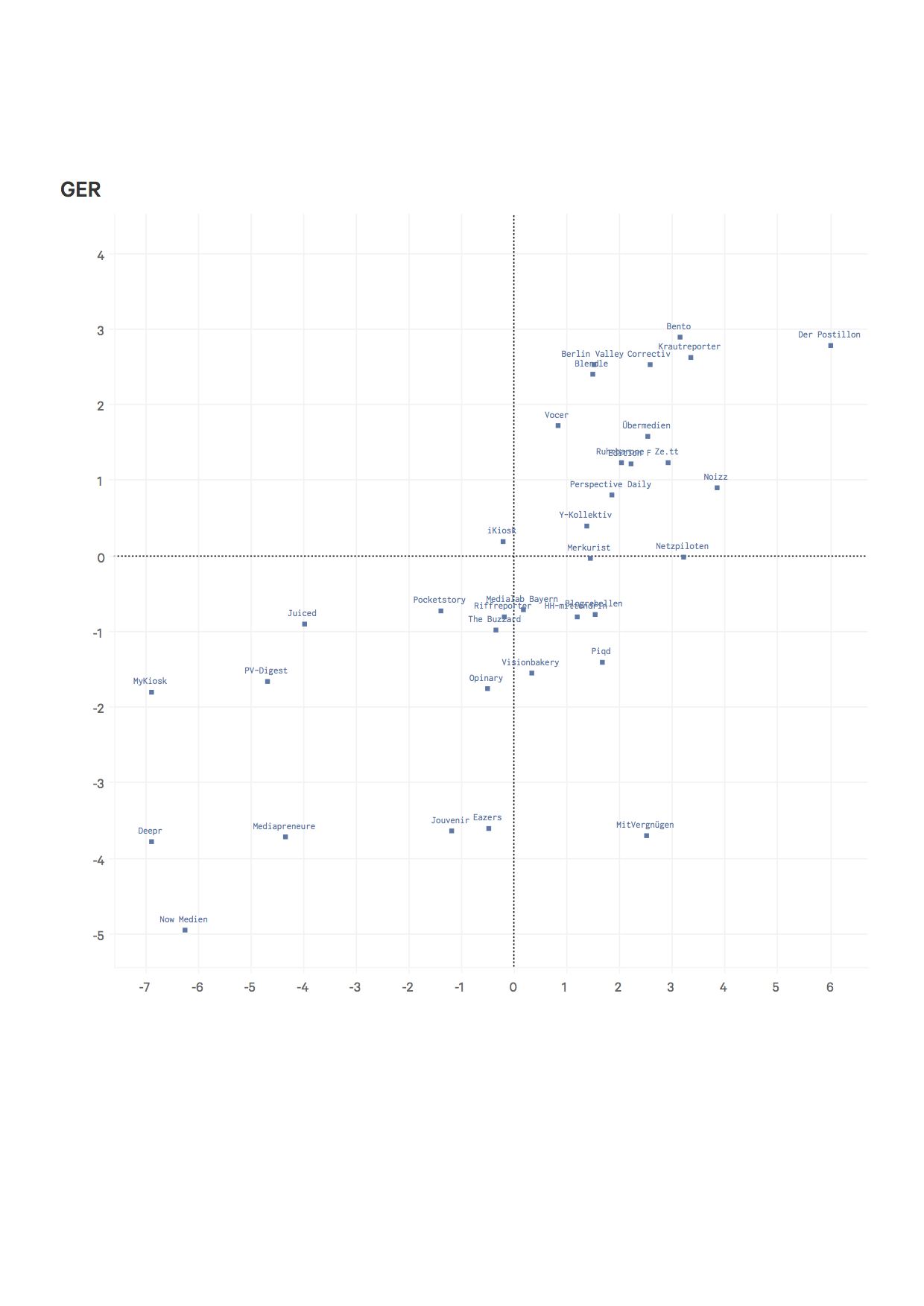
Symbolic capital and Market Success (USA):
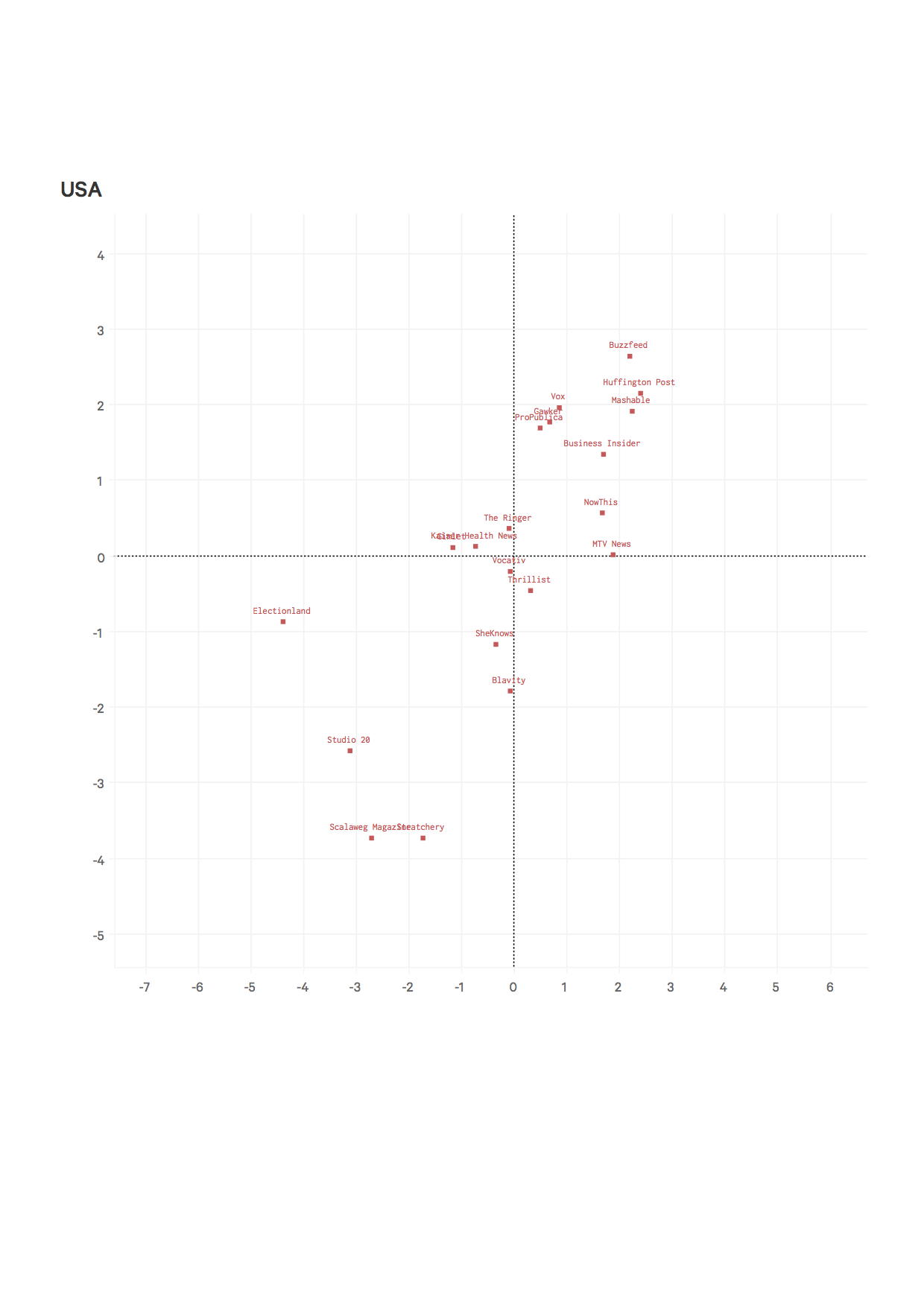
b. Exploring the innovation discourse
When looking at the key terms associated with these quadrants, we can see that the terminology differs. For Germany, we created two word clouds for the “Purists” and the “New Establishment”. For the “purists” in Germany, we find that terms like “PaidContent”, “Paywall” and “Geschäftsmodell” (business model) are mentioned, as well as “Verlage” (= publishers), and “Qualitätsjournalismus” (= quality journalism). This indicates that the discussion about the startups situated in the upper left corner, focuses on how to sell (quality) journalism in the new journalism economy. Startups in this group are for example Blendle or iKiosk, which both introduced new modes of the distribution of articles for publishers of old media. The new establishment, on the other hand, is rather represented by other actors such as bento, Krautreporter and Postillon: their follower numbers are high and they are mentioned frequently. The terms associated with them differ from the “purists”: here, we can observe terms like “Medienwandel” (change in media landscape), “Zukunft” (future) and “Storytelling”, which rather are terms of reinvention and innovation. Another way of reading this data was to look for unique terms. For example, when looking at the “purists” in the USA dataset, key words like democracy, transparency and credibility show up. This indicates that these players focus on quality and “old values” of journalism. For the “symbolically excluded”, however, we find terms like “advertisers”, “subscriptions” and “business model” - indicating that they have a focus on earning money rather than pursuing journalistic quality.Word cloud of innovation discourse for symbolically excluded actors (USA):

Word cloud of innovation discourse for symbolically excluded actors (DE):
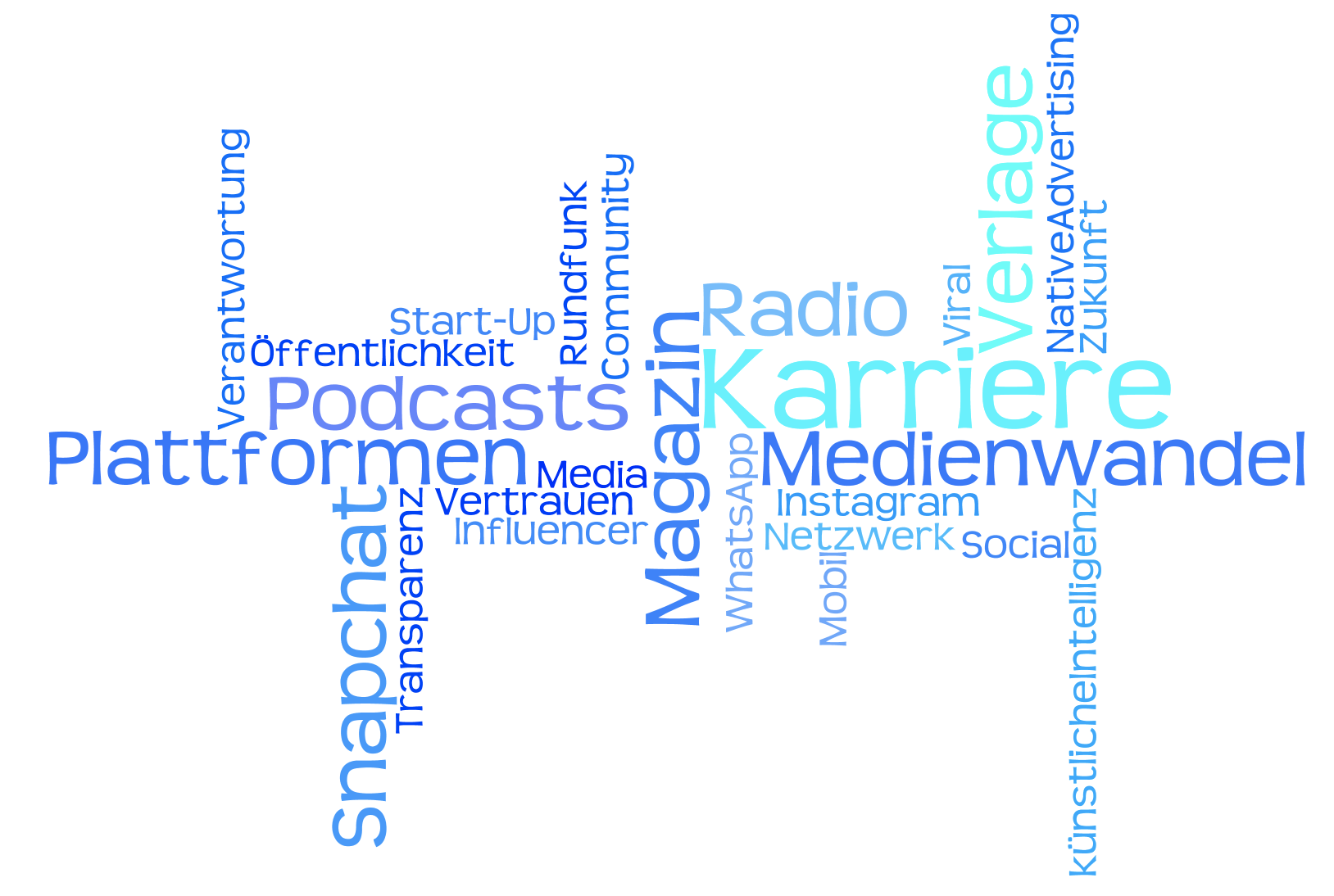
Word cloud of innovation discourse for purist actors (USA):

Unique terms for Symbolically Excluded and Purist actors (USA):
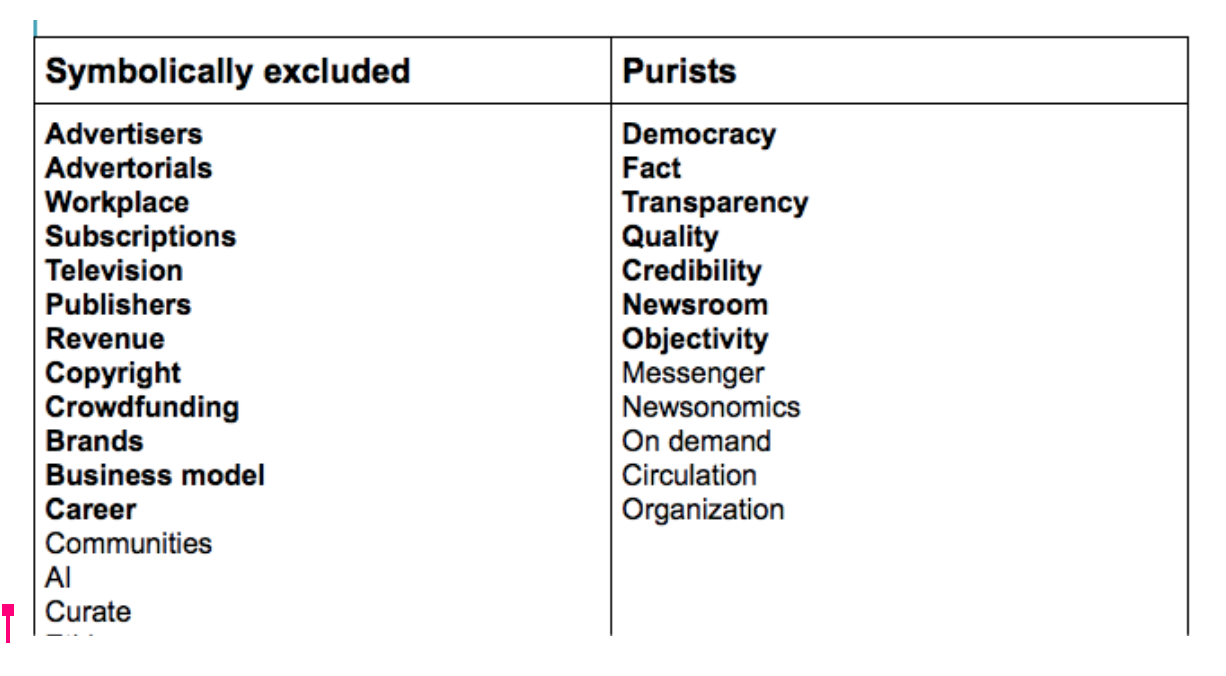
c. Tracing actor positions on Facebook
The network analysis reveals several distinct groups of actors in each page like network. The group of actors are in general clustered in two different ways: thematic and/or regional interests. This way of clustering is especially visible in the Dutch and German networks. The cluster around the startups allows us to see how actors position themselves in the network. Moreover, these positions appear in distinct ways. Indeed some startups take a specific position by clustering themselves around particular actors in the network (which can be categorized). Others, on the contrary, cannot be assigned to specific likes within one field of interest. The focus of this report are the highly visible startups within the network. Other startups, neglected within our scope of research, ‘fail’ to position themselves because of several unknown reasons. One reason for that could be the fact that they just entered the network recently, which results in low visibility. Another interesting finding is that the startups do not relate to each other (liking each other on Facebook) as expected in such an highly discussed debate around entrepreneurial journalism. The different networks rather show a form of clustering around single startups in terms of their own interests instead of connecting to each other as actors of the discussion.Actor positioning on Facebook (NL):
Looking at the Dutch startups, two main players are dominant: “Hardhoofd” and “Voordekunst”. They are both positioned in the center of the network and they both share a cluster which could be seen as Amsterdam-related and surrounding art and culture. It became clear that their focus is to inherit a semi-alternative social position with interest in art and culture.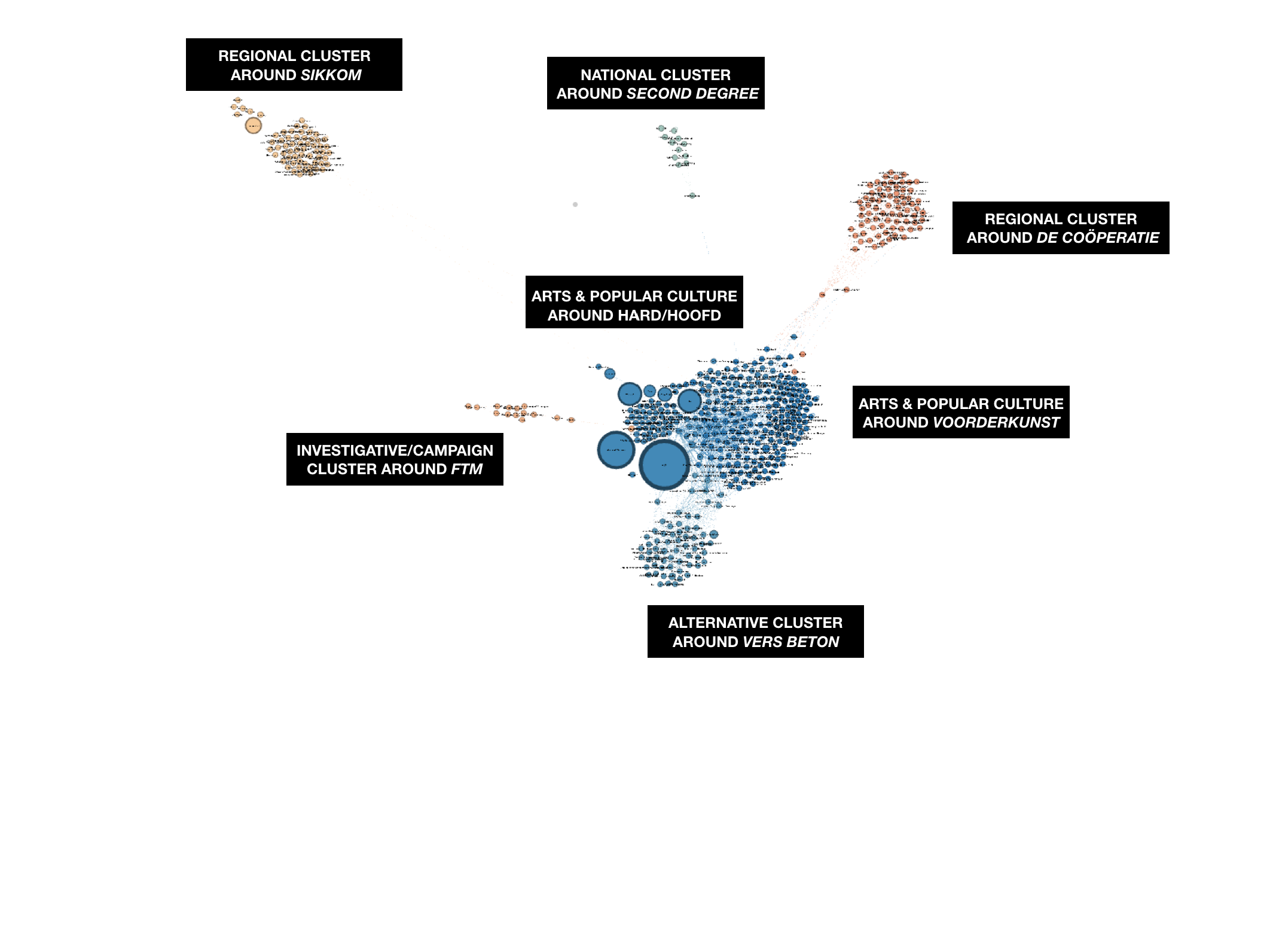
Actor positioning on Facebook via like networks (DE):
The German cluster of the startups are dominated by “BerlinValley” since this is a startup related magazine. They built a huge network in the German startup scene, particularly in Berlin, which is the geographical hotspot for the German startups (Hofmann, 2017). Comparing the Dutch with the German cluster, the same conclusion can be drawn: the startups position themselves (and each other) within thematical and regional clusters.
Actor positioning on Facebook via like networks (USA):
Within the cluster of the United States the biggest player is “Sheknows”, which is a glossy lifestyle website. Sheknows is positioned among popular lifestyle media, which is a very interesting finding compared to the findings of the Dutch and German page like networks. These networks are highly focused on alternative art and cultural topics. This is in contrast to the findings of the USA, since they rather focus on glossy popular mainstream media.
5. Discussion and Conclusion
As mentioned above, Bourdieu stated that in cultural fields, actors do not only compete for market success, but also for prestige or symbolic capital (Bourdieu, 91). Having conducted the extensive research described and explained above, it can be pinpointed that this observation can be applied onto new journalistic startups and institutions which we focused on during our research. It has become evident that new players in the journalistic field, such as startups, are indeed, taking certain positions within the media and cultural landscape. Moreover, these these positions are thematically and/or regionally framed. On the other hand, looking at the quadrants and the startups’ distributions among these graphs, it can be said that although mentions among the innovation discourse are often, the number of followers or likes does not necessarily has to act accordingly. This means, that although a startup has numerous followers and likes (high market success), it is not necessarily considered to be more innovative than others within the innovation discourse, according to this snapshot in time that we created. Needless to say, that this could also be the other way round, when facebook likes and followers are limited (low market success), but nonetheless a startup is mentioned often (high prestige). A position like that can be justified by the fact that a startup is brand-new within the scene and has created a lot of attention among the discourse actors, but was not (yet) able to set up a basis of numerous followers and likes. Concluding from this, a differentiation needs to be conducted in terms of declaring a startup highly successful in both characteristics, prestige as well as market success, in order to draw definite conclusions on a single startup’s position. This means that this research rather shows a snapshot in time on how startups are positioned in the entrepreneurial journalism landscape as well as how the discourse around them is conducted and executed. Further research could include to focus on particularly successful or unsuccessful examples of startups and investigate their positioning in depth and explore the reasons for this very positioning.References
Bourdieu, Pierre. Intellectual field and creative project. Information (International Social Science Council) 8.2 (1969): 89-119. Print. Broersma, Marcel & Chris Peters. 2016. “Introduction: Towards a functional perspective on journalism’s role and relevance.” In Rethinking journalism again. Societal role and public relevance in a digital age, edited by Chris Peters and Marcel Broersma, 1-17. New York: Routledge. Bruno, Nicola, Rasmus Kleis Nielsen. Survival is Success. Journalistic Online Start-Ups in Western Europe. Oxford: Reuters Institute for the Study of Journalism. 2012. Print. Carlson, Matt and Nikki Usher. 2015. “News Startups as Agents of Innovation. For-profit digital news startup manifestos as metajournalistic discourse.” Digital Journalism Cook, Clare, Pekka Pekkala. Sustaining journalistic entrepreneurship. In: Cook, Clare, and Mikihito Tanaka (eds.). Chasing sustainability on the net. (2012). Deuze, Mark, Tamara Witschge. Beyond journalism: Theorizing the transformation of journalism. SAGE Publications. 2017. Print. Hallin, Daniel and Paolo Mancini. 2004. Comparing Media Systems. Three Models of Media and Politics. Cambridge: Cambridge University Press. Hanitzsch, Thomas. 2007. “Deconstructing Journalism Culture: Toward a Universal Theory.” Communication Theory 17 (4): 367-385. Harbers, Frank. 2016. “Time to Engage. De Correspondent’s Redefinition of Journalistic Quality.” Digital Journalism 4 (4): 494-511. Hofmann, Alex. Warum Start-ups Berlin lieben. https://www.welt.de/sonderthemen/noahberlin/article165741012/Warum-Start-ups-Berlin-lieben.html. 2017. Online. McNair, Brian. 2013. “Trust, truth and objectivity: sustaining quality journalism in the era of the content-generating user.” In Rethinking journalism. Trust and participation in a transformed news landscape, edited by Chris Peters and Marcel Broersma, 75-88. New York: Routledge. Rogers, Richard. Digital Methods. MIT Press. 2013. Print. Singer, Jane. 2010. “Journalism Ethics amid Structural Change. Daedalus 139 (2): 89-99. Stevenson, Michael. “The Cybercultural Moment and the New Media Field.” New Media & Society, vol. 18, no. 7, Aug. 2016, pp. 1088–102. Wagemans, Andrea, Tamara Witschge and Mark Deuze. 2016. “Ideology as resource in entrepreneurial journalism: the French online news startup Mediapart.” Journalism Practice 10 (2): 160-177. Wahl-Jorgenson, Karin. 2016. “Is there a ‘postmodern turn’ in journalism?” In Rethinking journalism again. Societal role and public relevance in a digital age, edited by Chris Peters and Marcel Broersma, 97-111. New York: Routledge. Witschge, T. & Harbers, F. (in press). The Entrepreneurial Journalist. In: Eldridge S.A. & Franklin, B. (eds). The Routledge Handbook to Developments in Digital Journalism. Abingdon: Routledge.| I | Attachment | Action | Size | Date | Who | Comment |
|---|---|---|---|---|---|---|
| |
DUTCH page like network 1.png | manage | 470 K | 30 May 2018 - 12:58 | MichaelStevenson | Discursive positioning on Facebook (NL) |
| |
GER-scatter.png | manage | 125 K | 30 May 2018 - 12:49 | MichaelStevenson | Symbolic capital and Market Success (DE) |
| |
GERMAN page like network 1.png | manage | 789 K | 30 May 2018 - 12:59 | MichaelStevenson | Discursive positioning on Facebook via like networks (DE) |
| |
NL-scatter.pdf | manage | 103 K | 30 May 2018 - 12:50 | MichaelStevenson | Symbolic capital and Market Success (NL) |
| |
NL-scatter.png | manage | 124 K | 30 May 2018 - 13:07 | MichaelStevenson | Symbolic capital and Market Success (NL) |
| |
Purist wordcloud.png | manage | 275 K | 30 May 2018 - 12:43 | MichaelStevenson | Word cloud of innovation discourse for purist actors (DE) |
| |
PuristsUSAwordcloud.png | manage | 329 K | 30 May 2018 - 12:43 | MichaelStevenson | Word cloud of innovation discourse for purist actors (USA) |
| |
USA page like network 1.png | manage | 488 K | 30 May 2018 - 13:00 | MichaelStevenson | Discursive positioning on Facebook via like networks (USA) |
| |
USA-scatter.png | manage | 105 K | 30 May 2018 - 12:51 | MichaelStevenson | Symbolic capital and Market Success (USA) |
| |
Unique terms.png | manage | 283 K | 30 May 2018 - 13:31 | MichaelStevenson | Unique terms for Symbolically Excluded and Purist actors (USA) |
| |
excludedwordcloud.pdf | manage | 126 K | 30 May 2018 - 12:41 | MichaelStevenson | Word cloud of innovation discourse for symbolically excluded actors (DE) |
| |
excludedwordcloud.png | manage | 278 K | 30 May 2018 - 12:43 | MichaelStevenson | Word cloud of innovation discourse for symbolically excluded actors (DE) |
| |
symbolically excludedUSAwordcloud.png | manage | 399 K | 30 May 2018 - 12:37 | MichaelStevenson | Word cloud of innovation discourse for symbolically excluded actors (USA) |
Edit | Attach | Print version | History: r3 < r2 < r1 | Backlinks | View wiki text | Edit wiki text | More topic actions
Topic revision: r3 - 30 May 2018, MichaelStevenson
 Copyright © by the contributing authors. All material on this collaboration platform is the property of the contributing authors.
Copyright © by the contributing authors. All material on this collaboration platform is the property of the contributing authors. Ideas, requests, problems regarding Foswiki? Send feedback


